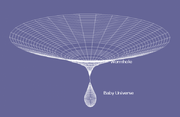

Two black holes linked by teleporting quantum entanglement exotic matter


A wormhole is a structure linking separate points in spacetime. It is created when a singularity of a black hole and/or a white hole become quantum entangled, causing information to be shared across the two in some way. It can connect any two points within a universe, or even different universes, or different points in time. It is a method for instantaneous travel once faster-than-light methods are too slow for vast interstellar or intergalactic distances, and critical for societal survival.
Passage through a wormhole begins with an exit station orbiting one of the mouths of the wormhole situated in flat-space about 300+ Astronomical Units (AU) from the transition, a region of the wormhole mouth extending from flat-space to a point a few AU from the wormhole throat. Thereafter approaching the throat is the vortex, where spacetime closes in around the traveler exponentially with decreasing distance. There is a caustic layer of exotic matter-energy (negative or phantom) surrounding the throat of the wormhole which holds it open. The throat is the spacetime constriction that links to the destination spacetime throat in the target wormhole. The size of the throat dictates the maximum size of any vessel transiting the wormhole and if larger is likely destroyed by the immense gravitational tide and shear stresses. With natural wormholes or early artificial wormholes, passage can take days due to acclimatization and careful navigation, but eventually it can be close to instantaneous. Gravitational time dilation is also an initial problem before higher dimensions are used by science.
Type II or beyond can set up a wormhole nexus which is a system of artificially connected wormholes leading to destinations within their existence, whether it is galactic or universal. It can eventually have millions of travel points, and each entry and exit station can be minor or major space stations (with habitats), making them economic hubs for space faring civilizations. An example of this is the Citadel.
Naturally occurring singularities of infinite curvature at both ends of a wormhole might only join two random points for an extremely short time before closing, so to keep them open and stable would require extremely advanced technology like creating a white hole at one end with its negative energy keeping the positive energy of the black hole at the other end in balance.
In the second picture, another possible technology shows two black holes linked by teleporting quantum entanglement exotic matter inside their singularities, then using a d-brane breach to use antimatter to open each end and create folded space between.
In Type IV or beyond, a wormhole can also link to a small artificially created universe (baby universe or basement universe) . This can be used for living space, computing or as an escape from a decaying universe.
Two types of wormholes:[]
- Traversable wormholes or stargates are very large, about 300+ AU radius from the region of flat-space to the wormhole mouth. This kind of wormhole uses a relatively small quantity of phantom ANEC (averaged null energy conditions)-violating energy.
- Communication wormholes are much smaller, but use a much larger amount of phantom ANEC-violating energy. They work by transmitting electromagnetic beams (usually light) containing data. This has limited bandwidth, but if quantum entanglement is perfected, and if a sufficient number of quantum pairs can be found (or made) between entry and exit points, qubit bandwidth can be boosted.
